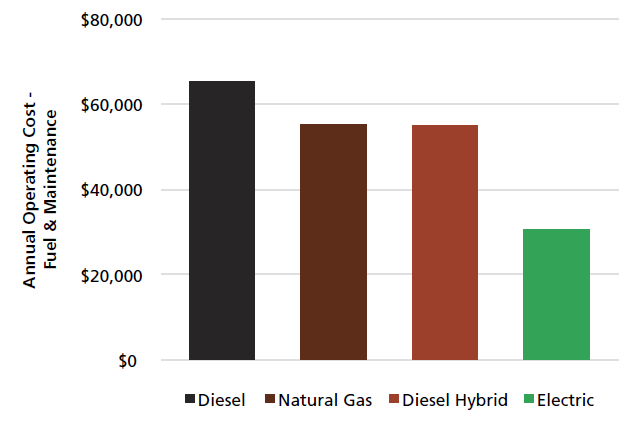Alana Miller
Policy Analyst
All-electric buses are here, and they’re cleaner, healthier and often cheaper for transit agencies, school districts and bus contractors to run in the long-term. To clear our air and protect our health, policymakers should accelerate the replacement of diesel and other fossil fuel-powered buses with clean, electric buses.
Note: For more recent electric bus adoption case studies, see our 2019 report Electric Buses in America.
Buses play a key role in in our nation’s transportation system, carrying millions of children daily to and from school and moving millions of Americans each day around our cities. Buses reduce the number of individual cars on our roads, make our communities more livable and sustainable, and provide transportation options for people of all ages and abilities.
Yet, the majority of America’s buses remain dirty – burning fossil fuels like diesel that put the health of our children and communities at risk and contribute to global warming:
Numerous studies have shown that inhaling diesel exhaust can cause respiratory diseases and worsen existing conditions like asthma. The negative effects are especially pronounced in children.
Diesel exhaust from buses poses a particular risk to health. Buses primarily travel where there are lots of people, including in the more densely-crowded areas of cities, on the busiest roads, and near schools. They also circulate continuously and make many trips, and therefore risk exposing many people to emissions.
The good news is that America can clean up its buses by making them electric. All-electric buses are here, and they’re cleaner, healthier and often cheaper for transit agencies, school districts and bus contractors to run in the long-term. To clear our air and protect our health, policymakers should accelerate the replacement of diesel and other fossil fuel-powered buses with clean, electric buses.
Dramatic declines in battery costs and improvements in performance, including expanded driving range, have made electric buses a viable alternative to diesel-powered and other fossil fuel buses.
Figure ES-1. Estimated Annual Operating Costs of Transit Buses, by Fuel Type[ix]

Cities in the United States and around the world are taking the lead, committing to transition to cleaner, quieter and more efficient electric bus fleets.
With reduced operating costs and no tailpipe emissions, all-electric buses and charging stations can be a smart infrastructure investment for school districts and transit providers across the country.
Electrifying buses is also an important first step towards broader adoption of heavy-duty electric vehicles, like trucks. While buses themselves account for a relatively small percentage of vehicle emissions, heavy duty vehicles as a whole are responsible for over a quarter of climate emissions from on-road transportation in the U.S.[xii]
To support more widespread adoption, state governments should:
Transit agencies, school districts and bus contractors should:
Prepare for future adoption of electric buses by running electrical conduits necessary for charging infrastructure during any new construction or reconstruction of depots and parking lots.
————-
[i] Robert Pudlewski, “When Will Alt-Fuels Replace Diesel, Gas Powered School Buses?” School Transportation News, 13 April 2017 archived at https://web.archive.org/web/20180217002454/http://stnonline.com/news/lat….
[ii] Federal Transit Administration, U.S. Department of Transportation, National Transit Database – 2016, October 2017.
[iii] International: World Health Organization, International Agency for Research on Cancer, “IARC: Diesel Engine Exhaust Carcinogenic” (press release), 12 June 2012, available at http://www.iarc.fr/en/media-centre/pr/2012/pdfs/pr213_E.pdf; U.S. Environmental Protection Agency, “IRIS Assessments: Diesel Engine Exhaust – CASRN NA,” 28 February 2003, archived at https://web.archive.org/web/20180412031944/https://cfpub.epa.gov/ncea/ir….
[iv] Quian Di et al., “Air Pollution and Mortality in the Medicare Population,” The New England Journal of Medicine, 376:2513-2522, DOI: 10.1056/NEJMoa1702747, 29 June 2017.
[v] Emissions savings calculated using Argonne National Laboratory’s Heavy-Duty Vehicle Emissions Calculator available at https://afleet-web.es.anl.gov/hdv-emissions-calculator. See methodology for full details.
[vi] Ibid.
[vii] Clinton Global Initiative V2G EV School Bus Working Group, ZEV School Buses – They’re Here and Possibly Free (presentation), 22 April 2016, available at https://green-technology.org/gcsummit16/images/35-ZEV-School-Buses.pdf.
[viii] Chicago Transit Authority, Electric Bus, accessed 6 February 2018, archived at https://web.archive.org/web/20180206213131/http://www.transitchicago.com….
[ix] California Air Resources Board, 5th Innovative Clean Transit Workgroup Meeting (presentation – slide 40), 26 June 2017.
[x] Fred Lambert, “12 Major Cities Pledge to Only Buy All-Electric Buses Starting in 2025,” Electrek, 23 October 2017, archived at https://web.archive.org/web/20180323201833/https://electrek.co/2017/10/2….
[xi] Metro: Los Angeles County Metropolitan Transportation Authority, “Metro Leads the Nation in Setting Ambitious 2030 Zero Emission Bus Goal; Takes First Step with Purchase of 100 Electric Buses”, (press release), 2 August 2017; Shenzhen: Michael Coren, “One City in China Has More Electric Buses Than All of America’s Biggest Cities Have Buses,” Quartz, 2 January 2018, archived at https://web.archive.org/web/20180323200300/https://qz.com/1169690/shenzh….
[xii] U.S. Environmental Protection Agency, Fast Facts: U.S. Transportation Sector Greenhouse Gas Emissions, 1990 – 2015, July 2017.
Policy Analyst
Policy Associate
